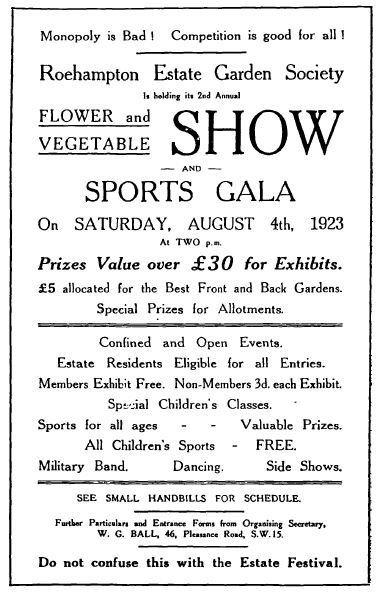Here’s something from Municipal Dreams on the Dover House estate, Putney. Quote of note:
This was a new working class whose living conditions and relative affluence combined with a self-conscious ‘respectability’ to create a more domesticated and private life-style, one that knowingly and happily distanced itself from the old intimacies of slum living. We saw this in the Wythenshawe Estate, Manchester, too. And as at Wythenshawe, gardening was a key indicator of the new way of life.
Yeah, I recognise my Basildon pioneer relatives there. Then, there’s this incredible not-even-faking poster.
Monopoly is bad. Competition is good for all! I’ve recently been reading Richard Overy’s The Morbid Age: Britain and the Crisis of Civilisation, 1919 – 1939, which is a sort of history of middlebrow ideas in interwar Britain. Quite by design, it doesn’t have sections on the great 20th-century narratives like communism, fascism, technology, feminism, etc – instead it covers things like the League of Nations association, popularised psychoanalysis, eugenics, and “planning”.
One of the things that sticks out is the enormous capability of civic culture at the time – a group of associations could just put on a national referendum like that, almost certainly because they called on the same volunteers who organised general elections although Overy doesn’t discuss logistics. Another thing that sticks out, though, is how much time and energy always goes into being wrong. Which leads me back to that poster; imagine a society that finds it necessary to politicise a flower show. What’s wrong with these people? That mid-century Vereinsleben, now much venerated, was deeply ambiguous.

Don’t forget that horticulture and flower contests were a feature of the old late C19th East End too. As were struggles over opening up parks and churchyards as public green space. The latter were usually set in motion by single-issue charities, but (as ever) the charities lacked staying power, and the LCC ended up taking them over. My source for alll this is a thesis I examined a few years ago: http://oro.open.ac.uk/29979/
Presumably If it wasn’t for the houses in between fits in there somewhere?